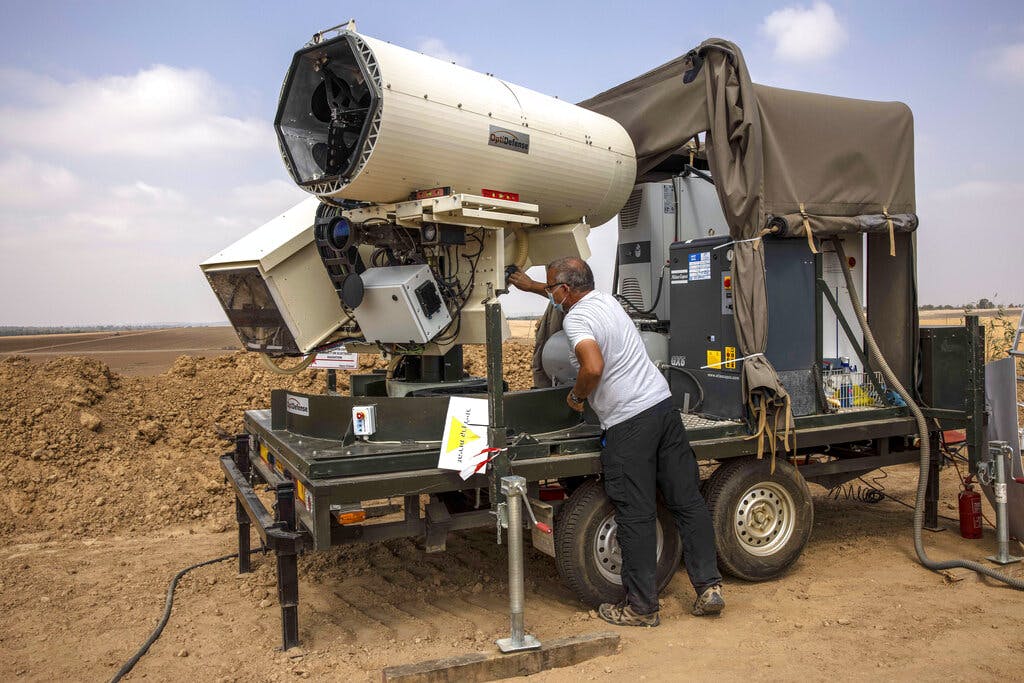New Israeli Laser System Offers Further Evidence Reagan Was a Visionary
The system is a ‘major step forward’ that will ‘impoverish our enemies,’ Prime Minister Bennett tweets.

Israelis describe their new laser-based defense system as a “game changer” that will transform the future battlefield. For the time being, it will at least change the costs of air and missile defenses.
Details disclosed today by Israeli officials spring from last month’s series of tests of the new system, dubbed Iron Beam. Prime Minister Bennett tweeted that the system is a “major step forward” that will “impoverish our enemies.” He suggested that these foes would invest a lot of money in missiles whose interception will be “very cheap — reversing today’s equation.”
Videos released by Israeli officials show how in the recent tests the new laser-based system successfully shot down drones, rockets, mortars, and anti-tank missiles.
Developed by the arms company Rafael in cooperation with the Defense Ministry R&D arm, Mapat, the new system will be deployed alongside, and complete, existing defense systems, including the Iron Dome and David Sling.
Asked when the laser system would become operational, several officials and military analysts told the Sun “soon,” but did not get more specific. Yet, officials say it could be sooner than the originally planned date, 2024. “Every effort is being made to make the system operational as soon as possible and enable an efficient, inexpensive, and innovative protection umbrella,” Defense Minister Benny Gantz said.
Somewhere in heaven President Reagan is smiling as his futuristic vision in the 1980s — widely derided as a “StarWars” dream when the Strategic Defense Initiative was first launched — is emerging as a dominant factor on the global battlefield.
SDI so scared the Soviet Union that Moscow beefed up its offensive capabilities to match America’s, and in doing so went beyond what it could afford — to the point that the arms race is seen by historians as a major factor in the Soviet demise that ended the Cold War in an American victory.
Today, American and Israeli anti-missile systems are deployed in Ukraine, the Arabian peninsula, South Korea, Japan, and elsewhere. Similar systems are developed by many countries.
Israel’s Iron Dome largely changed the way wars are fought by its enemies, including Gaza-based Hamas and Lebanon’s Hezbollah. The 80 percent interception rate of rockets launched by these terrorists against civilians in cities saves lives and allows the Israeli Defense Force to go on the offensive.
Yet, the current defense system’s costs are prohibitive.
Hamas’s midrange Qassam rockets are relatively crude and cheap. The cost of each Qassam is between $300 and $800. Interception is expensive: Each Iron Dome battery costs $50 million, and a single interception launch can run up to $150,000.
Similarly, last month the BBC reported that a Houthi drone that costs about $1,000 was intercepted in Saudi Arabia by an American-made Patriot missile worth $3 million.
The cost of developing the final stages of the Israeli laser-based defense system is reported to be more than $100 million, but using it will be cheap. As Mr. Bennett put it recently, interceptions would cost as much as an average electric bill.
The system has some drawbacks, including poor performance under cloudy skies and in other low-visibility conditions. But “we live in the Mideast, where the weather allows the use of lasers on most days,” writes a veteran war correspondent, Ron Ben Yishai.
Additionally, he writes, low visibility could be mitigated as the new weapon is able to be launched from warplanes as well as from ships or tanks. It could protect Israel not only against rockets and drones, but against ballistic missiles like the ones Iran is developing.
According to Mr. Ben Yishai, in the future the laser-based system could become an effective offensive tool as well. “I can’t elaborate at this point, but that is certainly a possibility,” he writes.
For now, it’s a system that could transform the battlefield in wars fought by Israel and its Abraham Accords partners. It is still in the prototype stage, Mr. Ben Yishai writes, but “if Ukraine had it, it would have saved us from helplessly watching the destruction we see at Mariupol and Kharkiv.”

